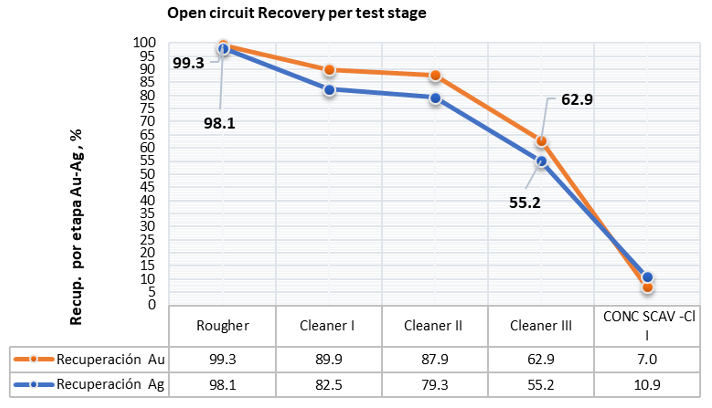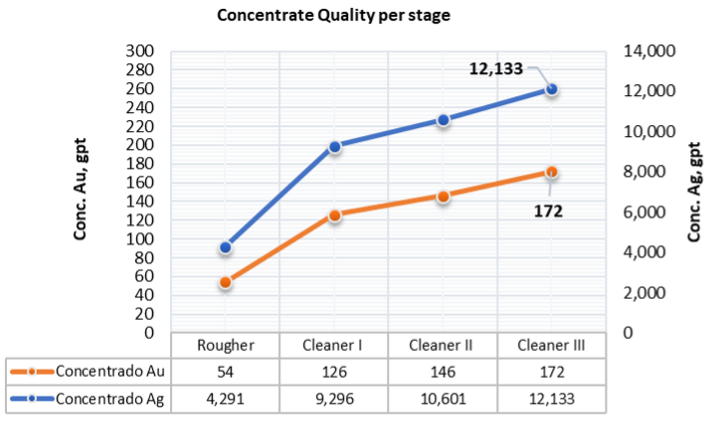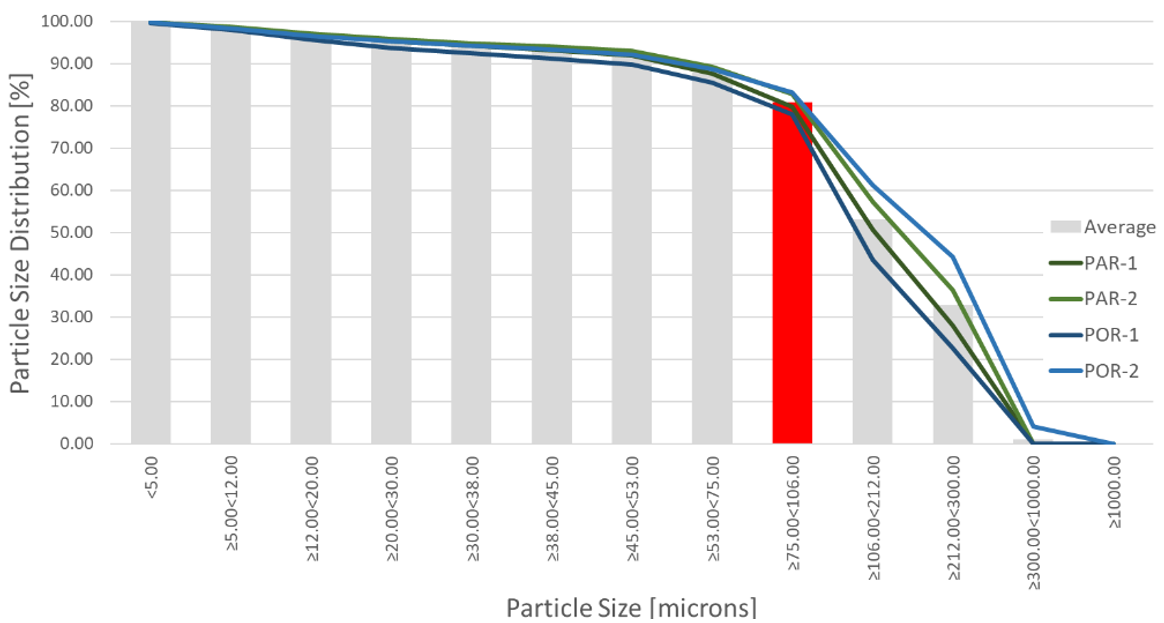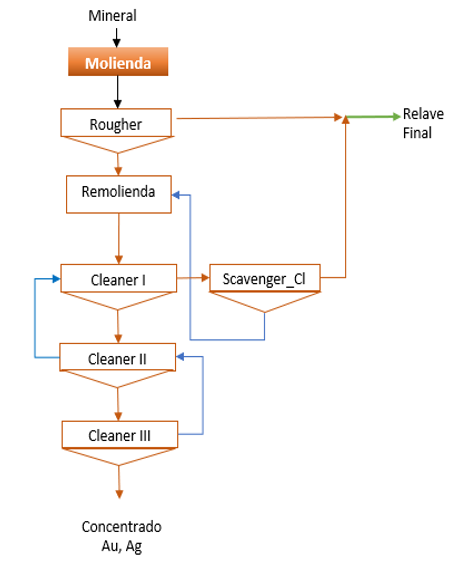News
Outcrop Silver Reports Exceptional Metallurgical Results - Confirming Recoveries of 93.4% Silver and 96.7% Gold
April 5, 2023 – Outcrop Silver & Gold Corporation (TSXV: OCG, OTCQX: OCGSF, DE: MRG1) (“Outcrop Silver”) is pleased to report excellent updated metallurgical results from the 100% owned high grade Santa Ana silver project in Colombia. The second phase of metallurgical testing was completed to confirm high recoverability using flotation and is a critical de-risking milestone for Santa Ana. The results will be incorporated in Santa Ana’s upcoming maiden resource report.
Highlights
- Testwork confirms flotation is an attractive recovery option for Santa Ana with excellent recoveries and concentrate grades
- Highly commerciable flotation concentrate grades of 12,133 grams per tonne silver and 172 grams per tonne gold
- Excellent global recoveries for silver and gold confirmed at 93.4% and 96.7%, respectively, consistent with previous metallurgical testing
- Flotation circuit times range between 2.5 and 10 minutes for cleaning stages with an efficiency of 97.6%, representing a standard residence time for a potential future operation
- Milling tests have shown that 105 microns is the optimum grain size for the flotation of the mineralized material
“We are delighted our metallurgical testing results confirm flotation as a viable option for the Santa Ana project with recoveries greater than 93%, and marketable concentrates of 12,133 grams per tonne silver and 172 grams per tonne gold with testwork performed with standard residence times and coarse grind,” commented Guillermo Hernandez, Vice President of Exploration. “Confirming flotation as a silver and gold recovery option with potentially high payables greatly reduces the potential environmental footprint, operating costs and permitting risk of the project.”
Outcrop Silver prepared four sample composites, two per mineralized shoot, from Ivana (POR-1 and POR-2) and Megapozo (PAR-1 and PAR-2) from coarse laboratory rejects. Each composite weighed approximately 50 kilograms, and the samples represent two metallurgical domains: high-grade and low-grade. The high-grade composites represent the average grade in the shoot, whereas the low-grade is estimated at 200 g AgEq/t, the threshold used to define significant silver equivalent grades. SGS Metallurgical Services Chile has conducted all preparation and testing.
The phase two metallurgical work consists of kinetic flotation circuit tests on the PAR-2 sample from the Megapozo target of the Paraiso vein. Table 1 shows the metallurgical balance per cleaner stage with a global recovery of 93.4% for silver and 96.9% for gold. The third cleaner stage produced a concentrate grading 12,133 grams per tonne of silver and 172 grams per tonne of gold.
Flotation times in the cleaner stages were 10, 6 and 2.5 minutes for the first, second and third stages, respectively. Additionally, the total time for the scavenger stage was 15 minutes aiming to maximize gold and silver recovery.

Table 1. Summary results with metallurgical balance per stage.

Table 2. Global recoveries from open circuit kinetic test.


Figure 1. Recoveries and concentrate quality per cleaner stage.
The particle size mass distribution shows more than 80% of sulphides are liberated from milling down to 100 microns. The currently selected grain size for the flotation tests is 105 microns for initial milling (Figure 2).

Figure 2. Particle size distribution in sulphide phases.
SGS Metallurgical Services Chile is currently performing locked-circuit flotation tests following the same reagent and residence times as used in the open circuit testing (Figure 3).

Figure 3. Locked-circuit flotation flow chart.
QA/QC
Core and rock samples are sent to either Actlabs or SGS in Medellin, Colombia, for preparation and AA assaying on Au and Ag; Pb and Zn for Actlabs as well and then sent to SGS Lima, Peru, for multi-element analysis. Samples sent to Actlabs are then shipped to Actlabs Mexico for multi-element analysis. In line with QA/QC best practice, approximately three control samples are inserted per twenty samples (one blank, one standard and one field duplicate). The samples are analyzed for gold using a standard fire assay on a 30-gram sample with a gravimetric finish when surpassing over limits. Multi-element geochemistry is determined by ICP-MS using aqua regia digestion. Comparison to control samples and their standard deviations indicate acceptable accuracy of the assays and no detectible contamination.
About Santa Ana
The 100% owned Santa Ana project comprises 27,000 hectares located in the northern Tolima Department, Colombia, 190 kilometres from Bogota. The project consists of five or more regional scale parallel vein systems across a trend 12 kilometres wide and 30 kilometres long. The Santa Ana project covers a majority of the Mariquita District, where mining records date to at least 1585. The Mariquita District is the highest-grade primary silver district in Colombia, with historic silver grades reported to be among the highest in Latin America from dozens of mines. Historic mining depths support a geologic and exploration model for composite mesothermal and epithermal vein systems having mineralization that likely extends to great depth. At Santa Ana, it is unlikely that there is sharp elevation restriction common to high-grade zones in many epithermal systems with no mesozonal component. The extremely high silver and gold values on Santa Ana reflect at least three recognized overprinting mineralization events.
At the core Royal Santa Ana project, located at the northern extent of just one of the regional vein systems controlled by Outcrop Silver, eight vein systems (commonly containing multiple parallel veins and multiple ore shoots) have been discovered to date – Santa Ana (San Antonio, Roberto Tovar, San Juan shoots); La Porfia (La Ivana hanging-wall and footwall); El Dorado (El Dorado, La Abeja shoots); Paraiso (Megapozo); Las Maras; Los Naranjos; Espiritu Santo and La Isabela. The Espiritu Santo and La Isabela veins are not included in the upcoming resource as they are still being defined. The veins can show both high-grade silver and high-grade gold mineralization, and low-angle veins appear to connect to more common high-angle veins.
Outcrop Silver drilling indicates that mineralization extends from surface or near surface to depths of at least 370 metres. Cumulatively, over 60 kilometres of mapped and inferred vein zones occur on the Santa Ana project. The Frias Mine on the south-central part of the project, 16 kilometres south of the Royal Santa Ana Mines, produced 7.8 million ounces of silver post-production in the Spanish colonial era at a recovered grade of 1.3 kg Ag/t. The Frias Mine is considered an analogue to each of the thirteen shoots discovered to date by Outcrop Silver. Numerous priority drill targets have been discovered along this 16 kilometres trend with outcropping veins up to 4.7 metres wide and surface values up to 9,740 grams silver per tonne.
About Outcrop Silver
Outcrop Silver is rapidly advancing the Santa Ana high-grade silver discovery with ongoing expansion drilling and an initial resource to be released in the coming months. Outcrop Silver is also progressing exploration on four gold projects with world-class discovery potential in Colombia. These assets are being advanced by a highly disciplined and seasoned professional team with decades of experience in Colombia.
Qualified Person
The technical information in this news release has been approved by Joseph P Hebert, a qualified person as defined in NI43-101 and President and Chief Executive Officer of Outcrop Silver.
ON BEHALF OF THE BOARD OF DIRECTORS
Joseph P Hebert
Chief Executive Officer
+1 775 340 0450
moc.dlogdnarevlisporctuo@trebeh.hpesoj
www.outcropsilverandgold.com
Kathy Li
Director of Investor Relations
+1 778 783 2818
moc.dlogdnarevlisporctuo@il
Neither the TSX Venture Exchange nor its Regulation Services Provider (as such term is defined in the policies of the TSX Venture Exchange) accepts responsibility for the adequacy or accuracy of this release. Certain information contained herein constitutes “forward-looking information” under Canadian securities legislation. Generally, forward-looking information can be identified by the use of forward-looking terminology such as “potential”, “we believe”, or variations of such words and phrases or statements that certain actions, events or results “will” occur. Forward-looking statements are based on the opinions and estimates of management as of the date such statements are made and they are subject to known and unknown risks, uncertainties and other factors that may cause the actual results, level of activity, performance or achievements of Outcrop Silver to be materially different from those expressed or implied by such forward-looking statements or forward-looking information, including: the receipt of all necessary regulatory approvals, capital expenditures and other costs, financing and additional capital requirements, completion of due diligence, general economic, market and business conditions, new legislation, uncertainties resulting from potential delays or changes in plans, political uncertainties, and the state of the securities markets generally. Although management of Outcrop Silver have attempted to identify important factors that could cause actual results to differ materially from those contained in forward-looking statements or forward-looking information, there may be other factors that cause results not to be as anticipated, estimated or intended. There can be no assurance that such statements will prove to be accurate, as actual results and future events could differ materially from those anticipated in such statements. Accordingly, readers should not place undue reliance on forward-looking statements and forward-looking information. Outcrop Silver will not update any forward-looking statements or forward-looking information that are incorporated by reference herein, except as required by applicable securities laws.
